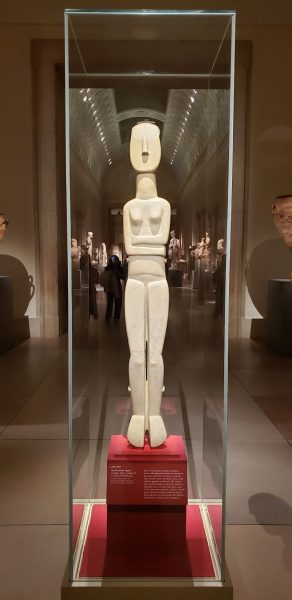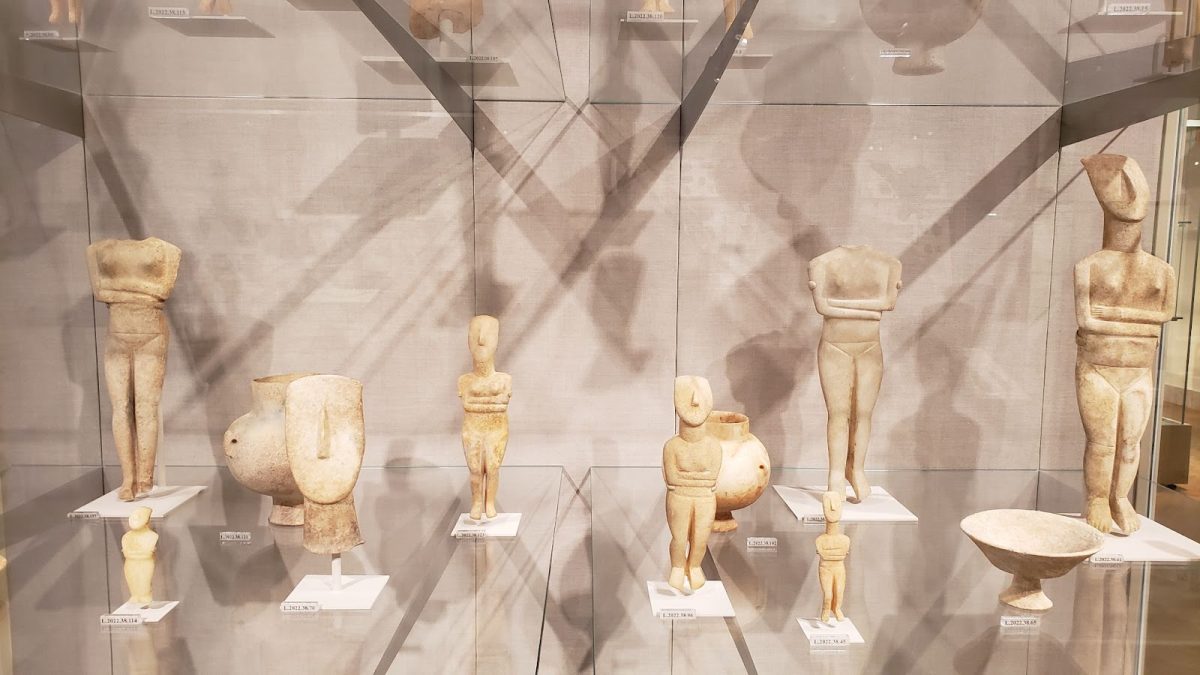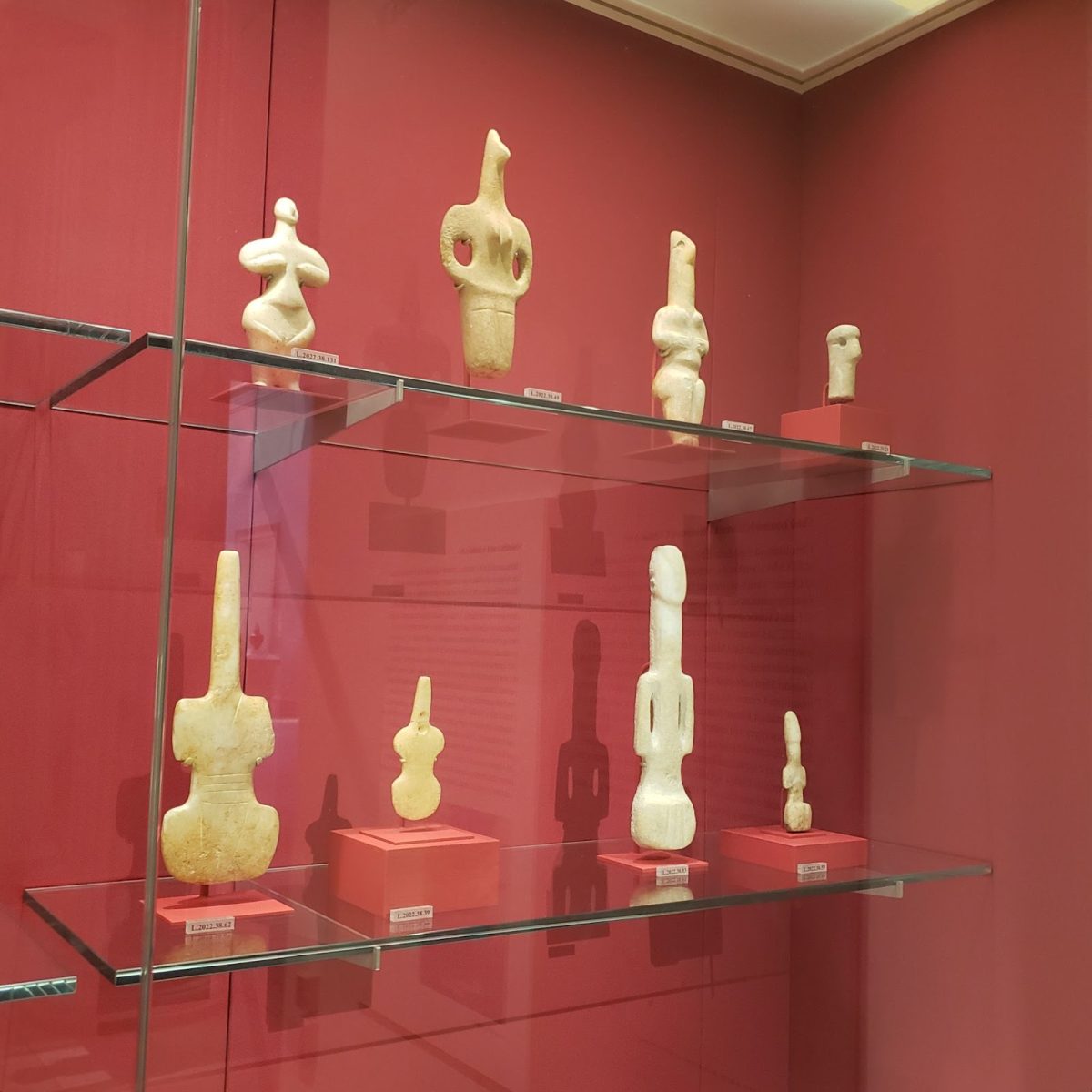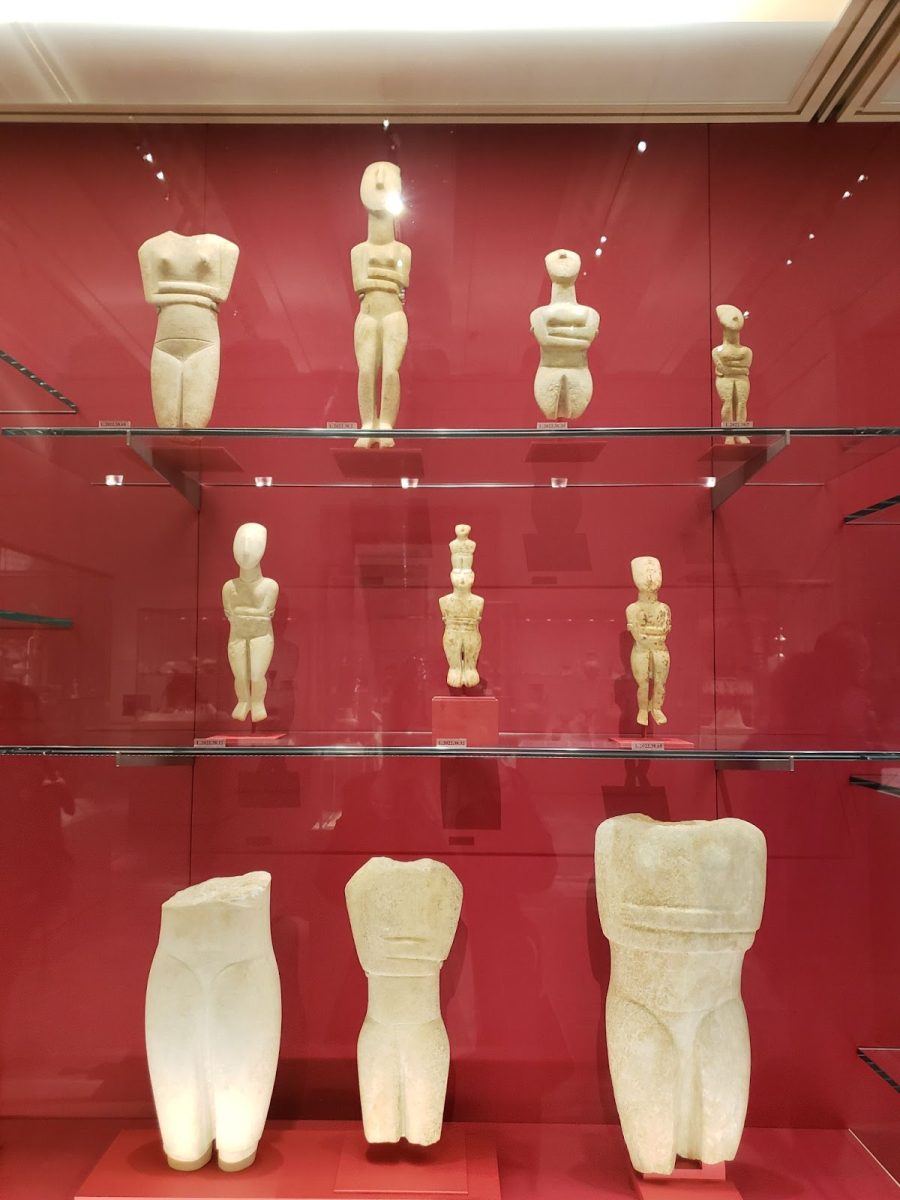The Greek and Roman Galleries at the Metropolitan Museum of Art, known for their magnificent, towering sculpture of the Greek Classical Period, have recently taken in some visitors of a considerably smaller stature but major influence. Traveling from the Museum of Cycladic Art in Athens, Greece, these Cycladic-era figures will stay for the next 25 years under ‘The Leonard N. Stern Collection on Loan from the Hellenic Republic.’
The exhibit draws mainly from Stern’s own collection, which started accumulating in the 1980s after becoming fond of them as a teenager. Stern, a New York billionaire philanthropist, repatriated his collection to Greece and helped work out the agreement between The Met and the Greek Government to create a long-term display of the sculptures. Curated by the head of the Met’s Greek and Roman Department, Sean Hemingway, and an assistant curator, Alexis Belis, the exhibit is the largest collection of Cycladic works in America.
Upon first entering the immense, opulent gallery, a humble, moderate-size ruby wall gathers unexpected attention. Most of the sculptures presented are of women, standing with their arms crossed over their midsection, retaining the iconic pose of Cycladic Art. Stoic in nature, the sculptures have an expressionless face, the only discernible feature being their wedge-shaped noses.

Victims of plunder, the sculptures were treated simply as objects of great affection instead of scientific artifacts from past civilizations. Their mysterious backstory is not the result of little research. The initial skyrocketing fame the sculptures experienced during their rediscovery in the 19th century delayed crucial, on-site primary research, creating a deficit in the timeline of Greek sculpture.
On loan from the Museum of Cycladic Art in Athens, Greece, the newly displayed 161 pieces of Cycladic antiquity are a testament to the survival of the influential sculptures despite their previous mishandling.
While these pieces now inhabit the Met, they all once lived on the Cyclades, a scattering of close-knit islands in Greece that developed a common culture in the late Neolithic era. The islands encircle Delos, the sacred birthplace of Olympians Artemis and Apollo, and are abundant in mineral resources such as iron ore, copper, and silver; all of which helped propel Cycladic civilization into the Bronze Age.
Despite the various minerals available on the islands, Cycladic sculpture is almost exclusively carved using marble. The small stature of the statues, most being around a foot in height, associate the intricate details of them with fine art. In burial sites in the area, a select few graves actually contain Cycladic sculpture, indicating that they were a relative luxury at the time.
The rediscovery of Cycladic figures in the 19th and early 20th century brought on a renewed interest in Greek history, comparative to what was seen during the Renaissance when classical Greek sculpture was reappraised. A similar interest was taken up by archeologists and regular travelers across Europe as they journeyed to the Cyclades in search of confirmation of the renowned Greek civilization, one that was only remembered through ancient texts.
A shock to Western society at the time, Cycladic art lent a certain mystery and charm as the minimalist figures appeared extremely modern in style. Soon, the alluring sculptures were selling to the highest bidder. Cycladic obsession crazed high society and delighted artists and dealers alike who looked to make a profit wherever possible.
Subsequently, many sculptures taken from the area, mostly through undocumented, rudimentary extractions, became objects of great desire. Cycladic art influenced many of the greats of the time, ranging from the fractured paintings of Pablo Picasso to the elongated features in the portraiture of Amedeo Modigliani.
Due to the high demand of Cycladic products, many figures were simply taken from where they lay, not considering the importance of documenting where, in what conditions, how, or why the sculptures may have been put there. Additionally, the sculptures come from a culture that did not have writing, meaning the chance of knowledge recovery is very slim.
This has led to a disconnect between the knowledge of what these sculptures’ purpose were, and the abundance of them that are accessible. Scientists and archeologists will never be able to definitively state the purpose of the Cycladic figures. That knowledge has been lost forever.
The sculptures, presented in various glass enclosures throughout their small showroom, take viewers on a journey through the periods of Cycladic Art. The first case presents sculptures of women, their shape resembling guitars or violins, from the Early Cycladic I period, known as the Grotta-Pelos. This experimental era evolved from ca. 3200 BCE to 2700 BCE, and consisted of blocky, rudimentary structures with less-defined features.
The Cyclades churned out more sculptures over the course of the Bronze Age; always utilizing marble to carve them, which under direct light emits a luminous halo – seemingly stemming like a soul from inside the sculpture – around the figure. The evolution of the sculptures, from abstraction to anthropomorphization back to abstraction, follows the islands they were found on.
The third vitrine from the right fully realizes the distinct Cycladic figure, showing an array of smaller, more natural forms of women. This later period of sculpture, known as the Keros-Syros culture, spanned from 2700 BCE to 2300 BCE and contains the most influential forms of Cycladic Art.
Further along the display, remains of a different kind show the circumstances in which different figures were found. Many are purposely broken, the head and body separated prior to being buried, which hints at a religious ceremonial importance. There have been other cases of sculptures having eroded and been repainted and repaired – outside of a funerary context – such as a small figurine whose leg was reattached, almost as if it were a toy a child had broken.
The multitudes of conditions in which these sculptures have been found is a testament to their diversity and potential. The evolution of the Cycladic pieces, from rigid to increasingly rounded, also conveys differences. In a collection of figurines most known for their uniformity and monotony, there are still undeniably unique pieces.
Walking past the displays of carved, pristine marble, it is easy to see a blur of familiarity. However, upon closer inspection that is clearly not the case. While the majority of museum goers have become attached to what’s considered “clean” art, the Met does not shy away from the abnormality of the sculptures, and appreciates the wide array of conditions which sculptures arrive in.
On the contrary, these Cycladic sculptures used to contain an array of tints and hues, brightly decorating whatever space they may have taken up. This use of color on sculpture is known as polychromy. However, over time the pigmentation of Cycladic sculptures faded and sometimes was purposefully scrubbed off before being put on display, as the public had come to associate the whiteness of a sculpture with purity.
At present, the sculptures can be appreciated for their previous distinction, being once painted, as well as their similarity and recognition as a motif across an extensive culture. Broadly, society is very divided, however when you hone in, we’re much more similar than meets the eye.
In spite of the poor historical knowledge of Cycladic Art, the exhibit highlights what can be learned and appreciated now about the sculptures. Through the partnership of The Metropolitan Museum of Art, the Ministry of Culture of the Hellenic Republic, and the Museum of Cycladic Art in Athens, visitors have broader access to Cycladic Art than ever before. The resources to learn about the construction of the sculptures and their influence in both ancient and modern times are now at the fingertips of the eight million people who live in New York City and the tens of millions who visit each year.
On loan from the Museum of Cycladic Art in Athens, Greece, the newly displayed 161 pieces of Cycladic antiquity are a testament to the survival of the influential sculptures despite their previous mishandling.



